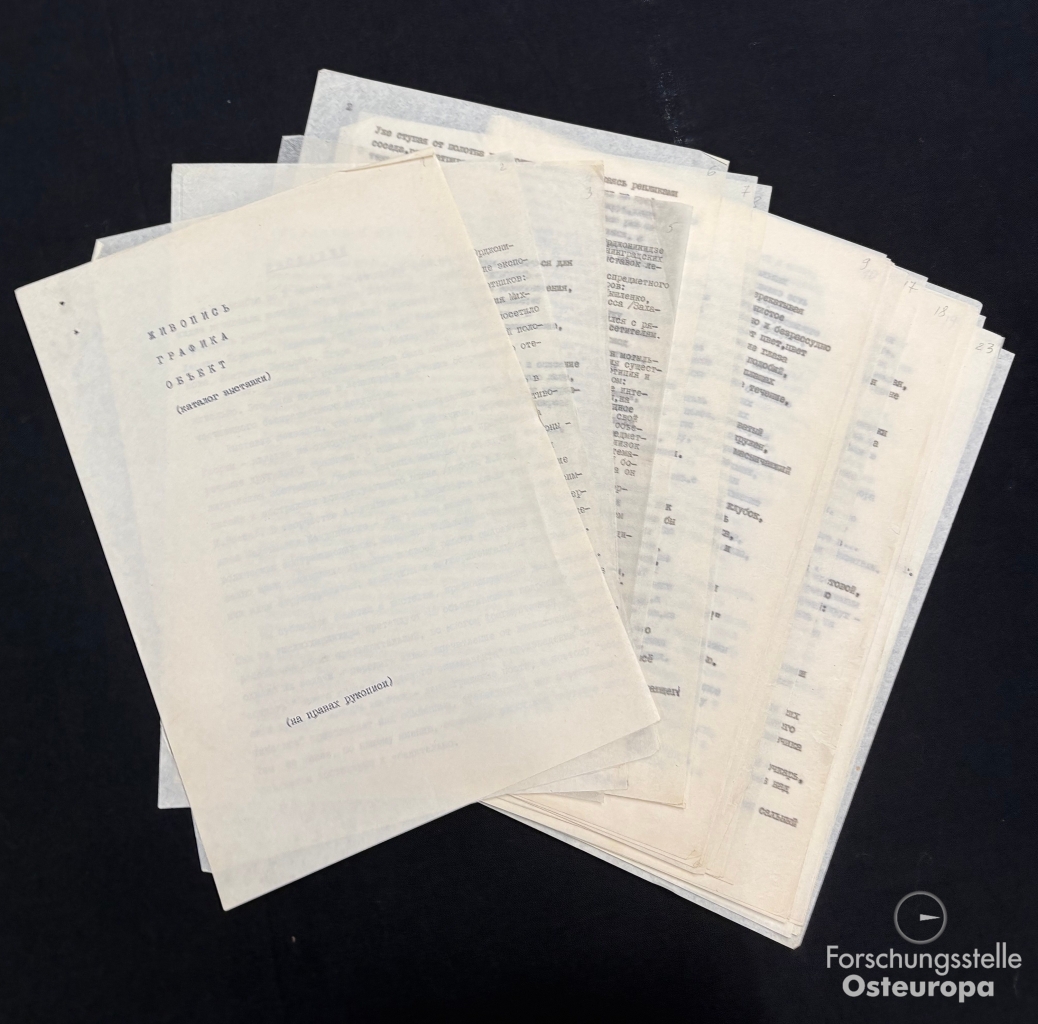Odesa-Tage 2025
Kolloquiumsvortrag
18:15 Uhr, / Zoom
Gun-Britt Kohler (Oldenburg) | Feld, Markt, Ideologie. Der belarussische Literaturbetrieb im ersten Drittel des 20. Jahrhunderts
Conference: Coming to the Surface or Going Underground? Art Practices, Actors, and Lifestyles in the Soviet Union of the 1950s-1970s
Research Centre for East European Studies (FSO)
Registration until 07.11.2025
Kolloquiumsvortrag
18:15 Uhr, / Zoom
Markian Prokopovych (Durham) | Dubious Legacies. Cities of Eastern, East-Central, and South-Eastern Europe, 1850-2000
Wissenswertes
“Painting. Graphics. Object”
A nonconformist art exhibition and its samizdat catalog
Draft of the samizdat catalog. Archive of the Research Centre for East European Studies. Photo: Georg Sokolov.
The 1970s in the Soviet Union were, among other things, a period of the nonconformist artistic movement on the rise. Various officially permitted exhibitions of unofficial art were held in Moscow and Leningrad. The groundbreaking show in Moscow was the Bulldozer Exhibition of 1974, followed by several shows in Leningrad that attracted large audiences. Among them, only two are consistently cited in accounts of Soviet cultural history: the major group exhibitions at Ivan Gaza Palace of Culture (1974) and Nevsky Palace of Culture (1975). These exhibitions featured dozens of unofficial artists, and their organization helped forge new connections among previously isolated groups and circles of creators. They also served as critical community-building events. Artists even formed the short-lived Association of Experimental Exhibitions as a kind of union intended to help them assert and defend their right to exhibit their work. More broadly, these developments reflected how artists, along with poets, musicians, scholars, and others, worked together toward a shared goal of resisting the oppressive state.
Even as the state attempted to divide and conquer the newly emerged community over the course of several years, artists were able to organize various other exhibitions with fewer participants, more specific scopes, and themes. Perhaps the most well-documented of these was an exhibition titled "Painting. Graphics. Object" held in November 1976 at the Sergo Ordzhonikidze Palace of Culture. The exhibition featured six artists — Leonid Borisov, Anatoly Vasiliev, Igor Zakharov-Ross, Yuri Dyshlenko, Yevgeny Mikhnov-Voitenko, and Anatoly Putilin — and was strikingly different from other nonconformist art exhibitions in the Soviet Union, because all of the participants exhibited abstract artwork. The radical nature of the exhibition was reflected, albeit cautiously, in the title. Modeled after traditional Soviet art categories, the title included the word "object," indicating that the boundaries of conventional media, such as painting and graphic art, had been transcended.
Perhaps the unprecedented nature of the exhibition prompted participants in the unofficial cultural scene to produce explanatory materials to contextualize the event. Unlike several other exhibitions, this one was accompanied by a samizdat exhibition catalog created by Arkady Dragomoshenko, Viktor Krivulin, and David Dar. The catalog included artists’ quotations, reproductions of their works, and essays written by the three authors, aiming to provide readers with the tools to understand non-objective art, which was still largely unfamiliar to the Soviet public.

Final version of the catalog. Archive of the Research Centre for East European Studies. Photo: Muriel Nägler.
The drafts preserved in the Research Centre for East European Studies’ archive show that a significant challenge lay in incorporating images directly into the text. The catalog was therefore organized as a portable guide for viewers. Paradoxically, however, the essays themselves were vague, offering general musings about the exhibited art. This can perhaps be explained by the fact that the three authors were poets and writers rather than artists or art critics. Readers were expected to understand that abstract art is intended to stimulate imagination and encourage further contemplation, rather than to convey a specific message.
Overall, the exhibition catalog for "Painting. Graphics. Object" stands out as a rare example of a samizdat publication that documents an artistic event and serves as a collaborative effort between artists and writers. In this collaboration, the writers served as mediators, facilitating the general public's engagement with complex artistic practices. Beyond its immediate purpose, the project strengthened networks within the nonconformist art community and contributed to the development of unofficial artistic activities in the 1980s.
Georg Sokolov
Further reading:
Andreeva, Ekaterina: Ugol nesootvetstviia: shkoly nonkonformizma. Moskva — Leningrad, 1946 –1991, Moscow 2012.
Novikov, Timur: Lektsii, St. Petersburg, 2003.
Georg Sokolov is a PhD candidate and a research associate at Constructor University Bremen. His thesis is dedicated to the emergence of Leningrad nonconformist art from the field of crisscrossing influences of the 1950s.
Länder-Analysen
» Länder-Analysen
» Eastern Europe - Analytical Digests
Discuss Data
Archiving, sharing and discussing research data on Eastern Europe, South Caucasus and Central AsiaOnline-Dossiers zu
» Erdgashandel
» Hier spricht das Archiv
» Russian street art against war
» Dissens in der UdSSR
» Duma-Debatten
» 20 Jahre Putin
» Protest in Russland
» Annexion der Krim
» sowjetischem Truppenabzug aus der DDR
» Mauerfall 1989

